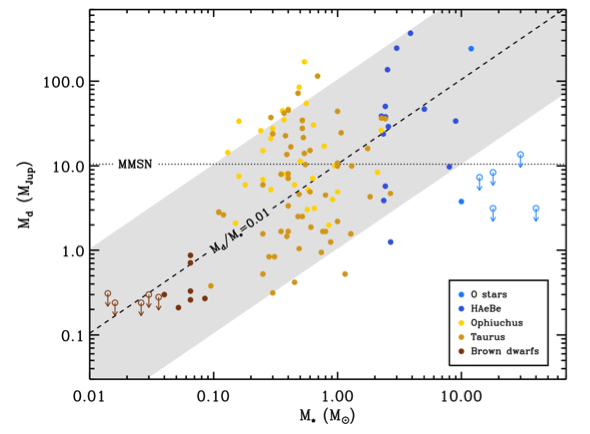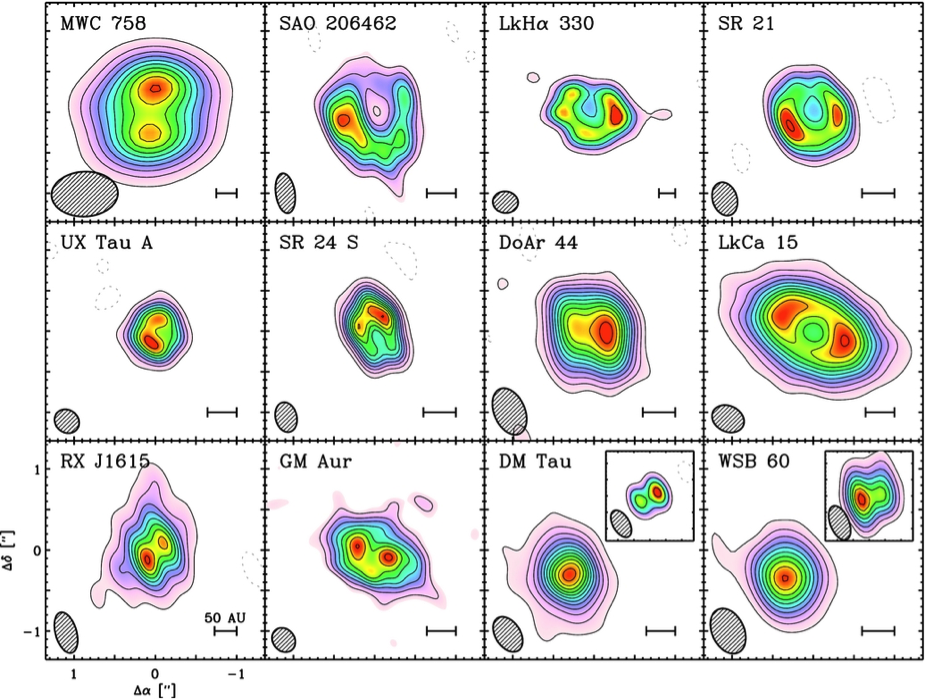Circumstellar Disks: Imaging dust in protoplanetary disks:
the mass budget and location of planet formation
The mass budget of solids, disk evolution and grain growth
As most protoplanetary disks are believed to be optically thin at these wavelengths, SMA observations are able to measure their dust mass, and this has allowed us to understand the budget of material that goes on to form planets. Through surveys of nearby star-forming regions at hundreds of parsecs from Earth, the SMA has taught us that disks evolve over timescales of several Myr, losing dust mass over time (e.g. Lee et al. 2011). At the same time, it provided evidence that grains are growing, as expected from the ongoing planet formation process (e.g. Lommen et al. 2007, 2010), and established that more massive stars host disks with larger amounts of dust (see Fig. 1, e.g. Andrews et al. 2013). As well as that, the SMA surveyed star-forming regions with very luminous (O- and B- type) stars such as Orion. These observations indicated that the dust mass of disks around other stars is eroded away by radiation from the very luminous stars, where this effect is strongest for disks nearest these stars (e.g. Eisner et al. 2008, Mann et al. 2009, 2010).

Figure 01: Dust masses of protoplanetary disks measured with the SMA around stars of different masses, showing a clear correlation (image from Williams and Cieza 2011).
References:
Kamiński et al., Nuclear ashes and outflow in the eruptive star Nova Vul 1670, 2015, Nature 520, 322
Other Resources:
https://www.eso.org/public/usa/news/eso1511/
The spatial distribution of dust disks, and inner cavities in transition disks
Where the SMA introduced the biggest advance for planet formation studies is in unveiling the distribution of this dust, through its high-resolution imaging capabilities. The SMA, for example, showed that the amount of dust decreases as a function of distance to the star (e.g. Andrews & Williams 2007, Hughes et al. 2008, Andrews et al. 2009), but this decrease is flatter than observed for the total amount of solids (including planets) in the Solar System (the Minimum Mass Solar Nebula, Weidenschilling et al. 1977). SMA resolved imaging surveys showed that the size of protoplanetary dust disks around single stars increases for more massive disks (Andrews et al. 2010a, Tripathi et al. 2017), and that disks in multiple stellar systems are truncated by the gravitational influence of companion stars (e.g. Andrews et al. 2010b, Harris et al. 2012).
One of the major breakthroughs in disk science brought by the SMA has been the confirmation of the existence of a subclass of protoplanetary disks named transition disks. These are forming planetary systems that present little to no dust in their inner regions, which clearly appear as large holes and cavities in SMA millimeter-wave high-resolution images (Fig. 2, e.g. Brown et al. 2008, Cieza et al. 2008, 2010, Hughes et al. 2009, Andrews et al. 2011). These cavities are believed to be most likely opened by the gravitational effect of forming Jupiter-like gas giants or stellar companions, preventing millimeter-sized dust from drifting into the star. Some of these have already been detected through observations at infrared wavelengths, such as the accreting protoplanet in the cavity of the LkCa 15 transition disk (e.g. Sallum et al. 2015).

